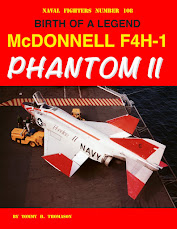The Sparrow "family" of missiles began with the Navy's desire to use guided missiles for air defense of its carriers. The first Sparrow was a so-called beam rider. The pilot aimed the plane's radar at a target and launched the missile, which was equipped with rearward facing antennas that detected the radar beam. The missile control system used that input to continually correct the Sparrow's direction of flight so as to stay more or less in the center of the beam and arrive close enough to the designated target for its proximity fusing to detonate its warhead (sort of a misnomer since it was actually located in the middle of the missile).
Various lengths for the Sparrow I can be found on the interweb but I'm relying on Craig Kaston's detailed measurement of the one at the Pt. Mugu museum for the above drawing. Note the sharply pointed nose for high speed flight, possible because the antennas were facing aft, not forward.
Craig also provided pictures of the forward fins, which provided the flight control, and the antenna fairings between the aft fins, which were fixed.
The Sparrow I failed to meet expectations. It was more or less operationally employed on the F3D-2M (the Skyknight was also used for much of its development as well), the F7U-3M Cutlass, and the F3H-2M Demon, but for only a year or two in each case.
VX-4 F3D-2M, Project Steam:
VX-4 F7U-3M shipboard evaluation:
Note the flare installation at the aft end of the missile.
I'm not sure what this was for. It may have been to provide visual tracking after the rocket motor burnout to get the missile back under control if it had not captured the beam after being launched.
Some comments on the F7U-3M can be found here: http://tailspintopics.blogspot.com/2012/12/cockpit-confusion.html
A VF-112 F3H-2M with a Sparrow I:
It appears that the operational Sparrow Is were painted black, although the pylon adapters appear to be painted sea blue, the aircraft color scheme that preceded the gray/white one.
Putting a radar in the nose of the Sparrow eliminated all the shortcomings of beam-riding and promised a near sure-kill after launch within its envelope and without any further involvement by the pilot of the interceptor. This was the Sparrow II:
Note that both the aft fins and forward wings have shapes different from the Sparrow I's. The forward wings have also been moved forward, either because of a cg change or to provide more control power for maneuverability. Douglas was promoting the Sparrow II for its F4D and F5D fighters and it was flight tested on the F4D.
The Navy continued to fund Sparrow II development for a while after the cancellation of the F5D. Then the Canadians briefly carried it forward as a weapon for the Avro Arrow program. In the end, incorporating a radar in the Sparrow proved to be a concept ahead of its time, one not fully realized until the Phoenix missile became operational.
The practical solution proved to be semi-active radar homing. This put a radar receiver in the nose of the missile that provided guidance based on the reflection from the target of the radar transmission from the fighter that launched it. This was the Sparrow III, as depicted in its July 1960 Standard Aircraft Characteristics chart (there were many detail changes over time):
The wings and fins were basically the same as those on the Sparrow II although the forward wings had been moved aft to roughly the same location as the Sparrow I's. It was first deployed on the F3H-2 (no suffix and equipped with a different radar than the F3H-2M; for more on the F3H, see http://tailspintopics.blogspot.com/2010/11/f3h-demon.html).
The Sparrow I and III used slightly different launchers. See http://tailhooktopics.blogspot.com/2011/05/f3h-sidewinder-and-sparrow.html
The combination of the Demon and Sparrow finally provided the fleet with an effective air-to-air missile defense against jet bombers. The F3H-2 was soon replaced by the F4H Phantom II,which was specifically designed to be a Sparrow-armed fighter.














No comments:
Post a Comment